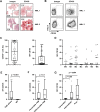CD105 (Endoglin) as negative prognostic factor in AML
- PMID: 31797971
- PMCID: PMC6892812
- DOI: 10.1038/s41598-019-54767-x
CD105 (Endoglin) as negative prognostic factor in AML
Abstract
While several genetic and morphological markers are established and serve to guide therapy of acute myeloid leukaemia (AML), there is still profound need to identify additional markers to better stratify patients. CD105 (Endoglin) is a type I transmembrane protein reported to induce activation and proliferation of endothelial cells. In addition, CD105 is expressed in haematological malignancies and the vessels of solid tumours. Here, CD105 associates with unfavourable disease course, but so far no data are available on the prognostic relevance of CD105 in haematological malignancies. We here generated a novel CD105 antibody for analysis of expression and prognostic relevance of CD105 in a cohort of 62 AML patients. Flow cytometric analysis revealed substantial expression in the various AML FAB types, with FAB M3 type displaying significantly lower surface levels. Next we established a cut-off specific fluorescence level of 5.22 using receiver-operating characteristics, which allowed to group patients in cases with CD105lo and CD105hi surface expression and revealed that high CD105 expression correlated significantly with poor overall and progression free survival. In conclusion, we here identify CD105 expression as a novel prognostic marker in AML, which may serve to optimize follow up and treatment decisions for AML patients.
Conflict of interest statement
The authors declare no competing interests.
Figures



References
-
- Kottaridis PD, et al. The presence of a FLT3 internal tandem duplication in patients with acute myeloid leukemia (AML) adds important prognostic information to cytogenetic risk group and response to the first cycle of chemotherapy: analysis of 854 patients from the United Kingdom Medical Research Council AML 10 and 12 trials. Blood. 2001;98:1752–1759. doi: 10.1182/blood.V98.6.1752. - DOI - PubMed
Publication types
MeSH terms
Substances
LinkOut - more resources
Full Text Sources
Medical

